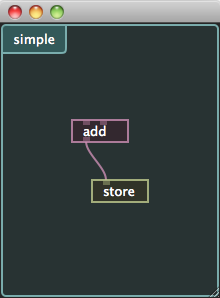Sync between editor and process
Mimas editor
This is the first tangible result concerning the graphical interface after the switch to Lua and Qt. The development in the new environment is a joy and things advance at a fast pace.
In this new context, writing tests by mocking parts of the system is really easy with Lua and greatly simplifies test driven development (especially for graphical elements). Difficult conceptual issues such as the relation between model and views remain but testing/fixing is just “command+R” away.
lk.Process sync
We have managed to make sync between lk.Process
and editor.Process
work. This implies many tools working together such as mdns (Zeroconf network discovery), zmq (zmq networking library), msgpack (binary serialization), mimas (Qt bindings), yaml (text serialization) and editor (Mimas application objects).
In the example below, the process has been automatically discovered on the network, patch information fetched and the process is drawn in the editor.ProcessView
.

Patch creation
Another big advance highlighted by this example is that patch definition works (with automatic loading of required lua code). Here is the “simple.yml” file with external “add” and “store” classes. We could have serialized these in the patch by using “script” instead of “class”.
add: class: add hue: 0.9 x: 70 y: 95 links: sum: store/in/value params: val1: 0 val2: 5 store: class: store hue: 0.2 bug: 0.7 x: 90 y: 155
The “add.lua” file contains this:
inlet('val1', 'First value [number].') inlet('val2', 'Second value [number].') sum = outlet('sum', 'Sends sum of first and second values [number].') val1 = val1 or 0 val2 = val2 or 0 function inlet.val1(v) val1 = v sum(val1 + val2) end function inlet.val2(v) val2 = v sum(val1 + val2) end
The “store.lua” file is like this:
inlet('value', 'Stores the value') function inlet.value(v) value = v end
Highlights
-

received funding for interface
Funding from the Swiss Federal Office of Culture to write the graphical frontend to rubyk !
-

Switched to mono-threading
Moving from a global mutex to a global select/poll loop.



comments